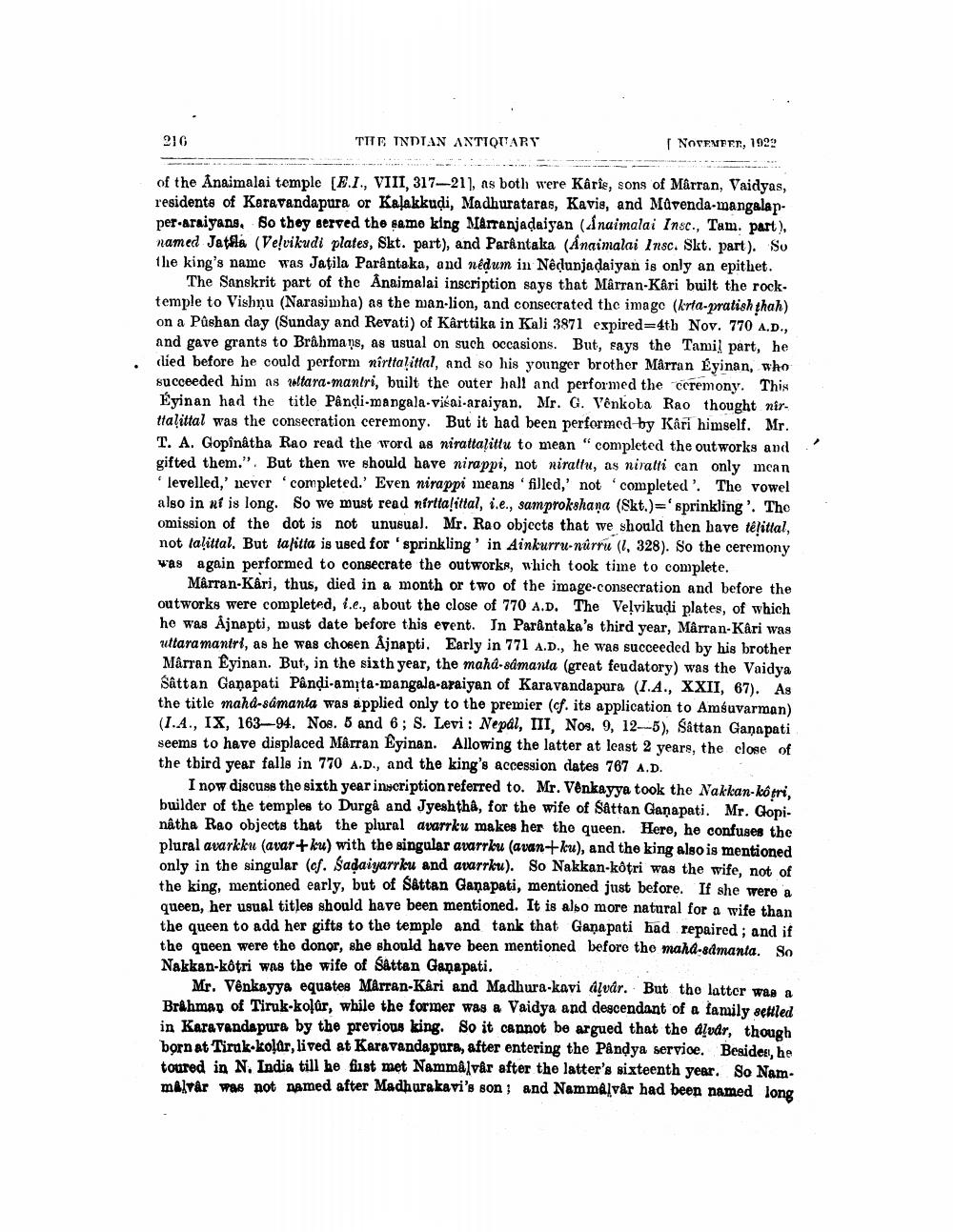________________
216
TITE INDIAN ANTIQUARY
NOTENEET, 1929
of the Anaimalai temple (E.I., VIII, 317--21), as both were Kâris, sons of Mårran, Vaidyas, residents of Karavandapura or Kalakkudi, Madhurataras, Kavis, and Mavenda-mangalarper-araiyans. So they served the same king Marranjadaiyan (naimalai Insc., Tam. part), named Jatila (Ve!vikudi plates, Skt. part), and Parantaka (Anaimalai Insc. Skt. part). So the king's name was Jaţila Parântaka, and nedum in Nêdunjadaiyan is only an epithet.
The Sanskrit part of the Anaimalai inscription says that Mârran-Kâri built the rock. temple to Vishnu (Narasimha) as the man-lion, and consecrated the image (krta-pratishthah) on a Pashan day (Sunday and Revati) of Kârttika in Kali 3871 expired=4th Nov. 770 A.D., and gave grants to Brahmans, as usual on such occasions. But, says the Tamil part, he clied before he could perform nirttalittal, and so his younger brother Marran Eyinan, who succeeded him as wtara-mantri, built the outer hall and performed the ceremony. This Eyinan had the title Pandi-mangala visai-araiyan, Mr. G. Venkoba Rao thought nir. ttalittal was the consecration ceremony. But it had been performed by Kári himself. Mr. T. A. Gopinatha Rao read the word as nirattalittu to mean "completed the outworks and gifted them.". But then we should have nirappi, not nirattu, as niratti can only mean
levelled,' never completed. Even nirappi means 'filled,' not completed'. The vowel also in ni is long. So we must read nirttalittal, i.e., samprokshana (Skt.) --' sprinkling'. The omission of the dot is not unusual. Mr. Rao objects that we should then have télittal, not talittal. But ta/itta is used for sprinkling' in Ainkurru-núrru (1, 328). So the ceremony was again performed to consecrate the outworks, which took time to complete.
Mârran-Kâri, thus, died in a month or two of the image.consecration and before the outworks were completed, i.e., about the close of 770 A.D. The Veļvikudi plates, of which he was Ajnapti, must date before this event. In Parantaka's third year, Mårran-Kâri was uttaramantri, as he was chosen Ajnapti. Early in 771 A.D., he was succeeded by his brother Mårtan Evinan. But, in the sixth year, the mahd-8dmanta (great feudatory) was the Vaidya Sâttan Ganapati Pandi-amta-mangala-araiyan of Karavandapura (1.A., XXII, 67). As the title mahd-samanta was applied only to the premier (cf. its application to Amsuvarman) (1.A., IX, 163-94. Nos. 5 and 6; S. Levi: Nepál, III, Nos. 9, 12--5), Sattan Ganapati seems to have displaced Mårran Eyinan. Allowing the latter at least 2 years, the close of the third year falls in 770 A.D., and the king's accession dates 767 A.D.
I now discuss the sixth year inscription referred to. Mr. Venkayya took the Nakkan-kôtri, builder of the temples to Durga and Jyeshthâ, for the wife of Sattan Ganapati. Mr. Gopinátha Rao objects that the plural avartku makes her the queen. Here, he confuses the plural avarkku (avar+ku) with the singular avarrku (avan+ku), and the king also is mentioned only in the singular (of. Sadaiyarrku and avarrku). So Nakkan-kôtri was the wife, not of the king, mentioned early, but of Sattan Ganapati, mentioned just before. If she were a queen, her usual titles should have been mentioned. It is also more natural for a wife than the queen to add her gifts to the temple and tank that Ganapati had repaired, and if the queen were the donor, she should have been mentioned before the mahd-8dmanta. So Nakkan-kôtri was the wife of Sattan Ganapati.
Mr. Venkayya equates MArran-Kâri and Madhura-kavi đļvár. But tho latter war a Brahmap of Tiruk-kosur, while the former was a Vaidya and descendant of a family settled in Karavandapura by the previous king. So it cannot be argued that the alvdr, though born at Thirukkolar, lived at Karavandapura, after entering the Pandya servioe. Besides, he toured in N. India till be fust met Nammâ vâr after the latter's sixteenth year. So Nammalvår was not named after Madhurakavi's son; and Nammalvår had been named long




